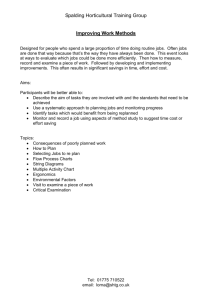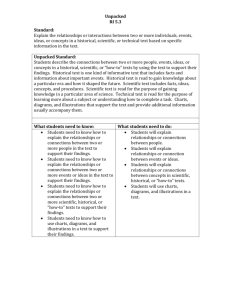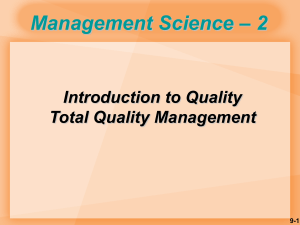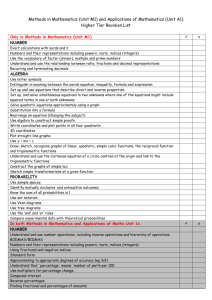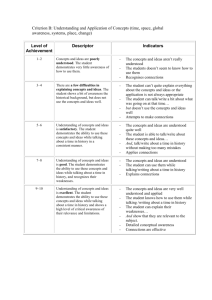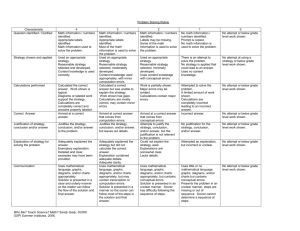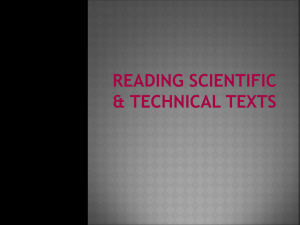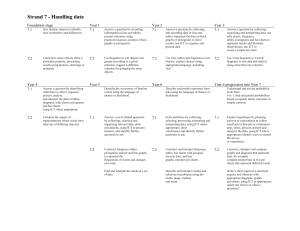PPMT CE 408
advertisement
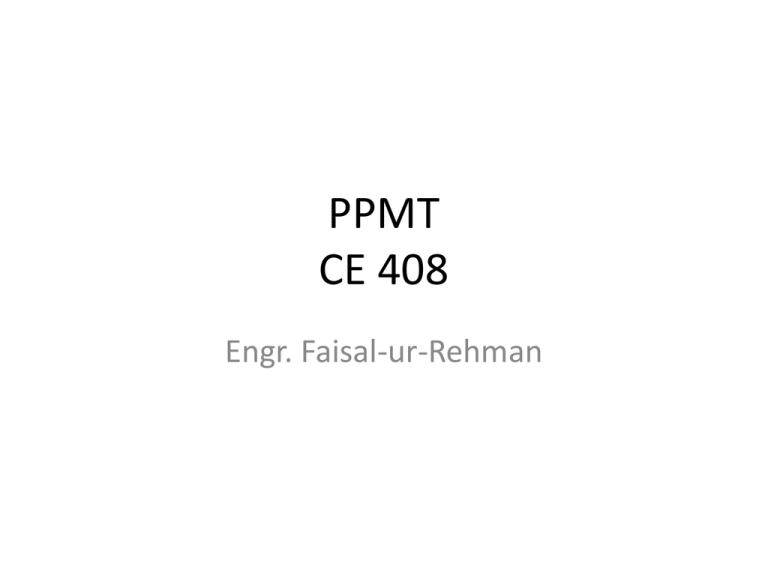
PPMT CE 408 Engr. Faisal-ur-Rehman Overview • Project Quality Management • Project Human Resource Management Project Quality Management • The Process of Quality Management ensure that the project will satisfy the needs for which it was undertaken. • Implemented by: – the policy, procedures – 3 sub processes • Quality Planning • Perform Quality Assurance • Perform Quality Control Project Quality Management • Quality Planning – identifying which quality standards are relevant to the project and determining how to satisfy them. • Perform Quality Assurance – applying the planned, systematic quality activities to ensure that the project employs all processes needed to meet requirements. • Perform Quality Control – monitoring specific project results to determine whether they comply with relevant quality standards and identifying ways to eliminate causes of unsatisfactory performance. Quality Planning Tools and Techniques 1. 2. 3. 4. 5. Cost-Benefit Analysis Benchmarking Design of Experiments (DOE) Cost of Quality (COQ) Additional Quality Planning Tools Quality Planning Tools and Techniques 1. Cost-Benefit Analysis The primary benefit of meeting quality requirements is less rework, which means higher productivity, lower costs, and increased stakeholder satisfaction 1. Benchmarking involves comparing actual or planned project practices to those of other projects to generate ideas for improvement and to provide a basis by which to measure performance. Quality Planning Tools and Techniques 1. 1. Design of Experiments (DOE) is a statistical method that helps identify which factors may influence specific variables of a product or process under development or in production. 1. It also plays a role in the optimization of products or processes. 1. It provides a statistical framework for changing all of the important factors, instead of changing the factors one at a time. 1. For example, automotive designers use this technique to determine which combination of suspension and tires will produce the most desirable ride characteristics at a reasonable cost. Cost of Quality (COQ) is the total costs incurred by investment in preventing nonconformance to requirements, appraising the product Quality Planning Tools and Techniques 1. Additional Quality Planning Tools Other quality planning tools are also often used to help better define the situation and help plan effective quality management activities. These include: a. b. c. d. e. f. g. brainstorming, affinity diagrams force field analysis nominal group techniques matrix diagrams Flowcharts prioritization matrices. Perform Quality Assurance (QA) Tools and Techniques • Quality assurance (QA) is the application of planned, systematic quality activities to ensure that the project will employ all processes needed to meet requirements. 1. Quality Planning Tools and Techniques 1. Quality Audits A quality audit is a structured, independent review to determine whether project activities comply with organizational and project policies, processes, and procedures. a. The objective of a quality audit is to identify inefficient and ineffective policies, processes, and procedures in use on the project. Perform Quality Assurance (QA) Tools and Techniques • Process Analysis follows the steps outlined in the process improvement plan to identify needed improvements from an organizational and technical standpoint. – Process analysis includes root cause analysis Quality Control Tools and Techniques Cause and Effect Diagram Cause and effect diagrams, also called Ishikawa diagrams or fishbone diagrams, illustrate how various factors might be linked to potential problems or effects. Quality Control Tools and Techniques • Control Chart – A control chart's purpose is to determine whether or not a process is stable or has predictable performance. – Control charts may serve as a data gathering tool to show when a process is subject to special cause variation, which creates an out-of-control condition. – Control charts also illustrate how a process behaves over time. Quality Control Tools and Techniques Quality Control Tools and Techniques • Flow Charting: Flowcharting helps to analyze how problems occur. • A flowchart is a graphical representation of a process. Quality Control Tools and Techniques Quality Control Tools and Techniques • • • • • • • Histogram Pareto Diagram Run Chart Scatter Diagram Statistical Sampling Inspection Defect Repair View Project Human Resource Management • Project Human Resource Management includes the processes that organize and manage the project team. • The project team is comprised of the people who have assigned roles and responsibilities for completing the project. Project Human Resource Management • Human Resource Planning - Identifying and documenting project roles, responsibilities, and reporting relationships, as well as creating the staffing management plan. • Acquire Project Team - Obtaining the human resources needed to complete the project. • Develop Project Team - Improving the competencies and interaction of team members to enhance project performance. • Manage Project Team - Tracking team member performance, providing feedback, resolving issues, and coordinating changes to enhance project performance. Human Resource Planning: Tools and Techniques • Organization Charts and Position Descriptions – Hierarchical-type charts – Matrix-based charts – Text-oriented formats • Networking - Informal interaction with others in an organization or industry is a constructive way to understand political and interpersonal factors that will impact the effectiveness of various staffing management options. • Organizational Theory - Organizational theory provides information regarding the ways that people, teams, and organizational units behave. Manage Project Team: Tools and Techniques • Observation and Conversation • Project Performance Appraisals • Conflict Management – Successful conflict management results in greater productivity and positive working relationships. – Sources of conflict include scarce resources, scheduling priorities, and personal work styles. Manage Project Team: Tools and Techniques • Conflict Management – Team ground rules, group norms, and solid project management practices, like communication planning and role definition, reduce the amount of conflict. – When managed properly, differences of opinion are healthy, and can lead to increased creativity and better decision-making. – When the differences become a negative factor, project team members are initially responsible for resolving their own conflicts. Manage Project Team: Tools and Techniques • Issue Log - As issues arise in the course of managing the project team. • A written log can document persons responsible for resolving specific issues by a target date. • The log helps the project team monitor issues until closure • Issue resolution addresses obstacles that can block the team from achieving its goals. • These obstacles can include factors such as differences of opinion, situations to be investigated, and emerging or unanticipated responsibilities that need to be assigned to someone on the project team. Q&A • Thanks

